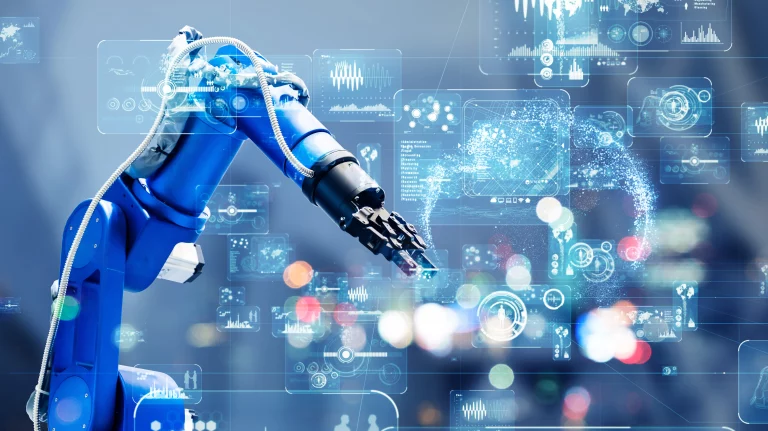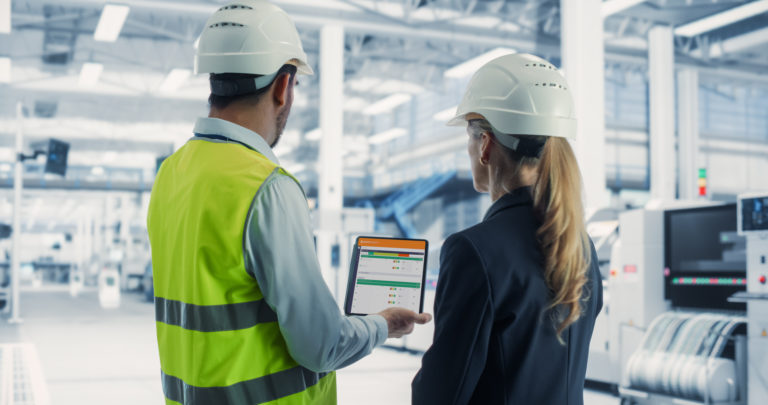Mar 25, 2025
How sustainability in production delivers measurable results
Companies that make their manufacturing operations sustainable reap economic benefits: they cut costs through energy-efficient processes and demand-driven resource planning, reduce waste and emissions, and comply with regulatory requirements. At the same time, they position themselves as leaders for customers and partners who also focus on sustainability. The results of a strategy that is both sustainable and digital are most visible in manufacturing and production, where the metrics that demonstrate the impact of sustainable and digital efforts are created. Two cases show what software-defined automation and digital twins can do for battery recycling and machine manufacturing, respectively.
Regardless of whether companies are required by law to make their business more sustainable, or whether they want to align ecology, economy, and social issues out of conviction or strategic considerations: The long-term opportunities and benefits lie primarily in these areas:
- Use resources efficiently
- Saving energy
- Reduce production cost
Achieving circularity in production
Those who want to align their production even more closely with the principles of the circular economy go one step further. The focus then shifts to achieving circularity in production. The first step is to use life cycle assessments to understand what resources are used when and where in production, and to know the energy and material consumption of individual production units. The next step is to create the conditions for closed loops: energy is sourced from renewable sources, products can be reused or recycled at the end of their life cycle, and production processes generate less waste that can be reintroduced into production. A key component is product design that ensures materials and components can be easily separated, repaired, or reused to build recyclability into the design phase. These approaches not only help reduce the environmental footprint, but also create long-term economic benefits by conserving resources and securing raw materials.
However, challenges such as high investment costs and adapting existing supply chains need to be considered. At the same time, socially sustainable approaches, such as supporting local employment, offer additional potential. By combining proven processes with new technologies such as additive manufacturing or targeted retrofits, companies can implement circular production methods more efficiently.
Combining digitization and sustainability
Strategy is one thing. Implementing it successfully requires not only investment and innovation, but also advanced technologies that make processes more efficient and measurable. In addition, the action plans resulting from the strategy must be implemented in such a way that they deliver measurable results. Digitalization therefore plays a crucial role in the implementation of sustainability measures in production. It provides the technologies, such as digital twins, automation solutions, or artificial intelligence (AI), and the data that can be used to measure whether the implementation of the measures is successful both ecologically and economically. In particular, digital twins can help to virtually simulate and optimize production processes, while automation and AI enable precise control and adjustment of resource utilization. The parallel transformation towards a digitalized and sustainable production method is referred to as the "twin transition". It is considered the key to the success of change processes.
Achieving sustainability with data and technology
12.7 million tons of CO2 can be saved in industry by 2030 through accelerated digitization, according to the study "Klimaeffekte der Digitalisierung 2.0" by Bitkom e.V. (German only). According to the study's findings, two technologies are crucial for this. The first is production automation. It ensures that processes in networked systems, machines, workpieces and components run independently and with the lowest possible use of materials and energy. The other is digital twins, virtual representations of real processes and machines. They allow innovations or changes and adaptations to processes and systems to be implemented and optimized digitally before they are transferred to the real production world. This saves material, energy and labor.
Two use cases show what examples already exist in practice.
Example 1: Up to 29.5 percent energy savings in machine tool manufacturing with digital twins
Machine tools play a central role in manufacturing companies. To change their shape, machining - turning, milling, drilling and grinding - is an important step in production. Cooling lubricants are often used in this process. But their use comes at a high energy cost. So high, in fact, that a consortium of research and industry partners - including us - have joined forces to develop measures to reduce energy consumption and increase productivity in the E-KISS* project, which is funded by the German Federal Ministry of Economics and Technology (BMWK).
E-KISS combines various technologies such as data science, digital twins and retrofit measures. The role of the digital twin was to map the complete digital picture of the real systems, i.e. the plant with its properties, states, dependencies and the behavior of the systems among each other. With the focus and objective of "achieving energy savings in the coolant supply", it was particularly important to capture data on processes, tools and workpieces and to continuously record changes. Through this data-based modeling of the system, we developed the basis for approaches and methods to optimize energy consumption in the research network.
The result at the end of the project was impressive: the machine tool coolant production facility consumed 13,590 kilowatt-hours less per year, a 29.5 percent reduction in electricity. This was only possible thanks to the interplay of sustainable goals, retrofit measures that affected individual components, data science to collect and interpret the data, and the digital twin as a key technology for analyzing and optimizing processes.
Read the full use case here: How digital twins help save up to 29.5 percent energy in mechanical engineering
Example 2: Digital twins optimize battery recycling
The future of mobility is electric. Many electronic vehicles rely on lithium-ion batteries. However, the lifecycle of batteries has a significant impact on the environment, from the extraction of raw materials to the energy used in production and disposal. Battery recycling sounds like a good solution, but in reality it often fails: there are many battery manufacturers, a wide range of different battery packs, and no single raw material is used in the individual batteries. As part of the ZIRKEL* research project, funded by the German Federal Ministry of Education and Research (BMBF), an interdisciplinary consortium from industry and research is investigating how automation solutions can help disassemble batteries on a large scale. The goal of ZIRKEL is to improve the ecological footprint of batteries. At the same time, the productivity and efficiency of the dismantling, separation and cutting processes for battery systems and electric motors are to be sustainably increased. To carry out these processes, Liebherr Verzahntechnik built a system whose digital image we created using our Digital Twins.
The result: the digital twins were able to capture the real processes, determine the optimal recycling path through data analysis, determine and optimize the material cycles, and contextualize the data for AI-based analysis. The data was stored in a database to ensure the traceability of the recycled components for the EU Battery Pass. Acting as a data hub, the digital twins orchestrate a seamless flow of information between all stakeholders, increasing process efficiency, flexibility, and cost-effectiveness.
In short, the digital twins promote a sustainable circular economy in the field of electromobility.
More about the project: Circular Economy: The crucial role of digital twins from Ascon Systems in battery recycling
The BMBF will present the results of ZIRKEL at the Hannover Messe 2025 (March 31 to April 4, 2025, Hall 2, Stand A35).
*E-Kiss funding code: 03EN2037B; the E-KISS project partners include (besides us): Robert Bosch GmbH, ONLINE Industrieelektrik und Anlagentechnik GmbH (Online IAT), Technische Universität Braunschweig (IWF).
*ZIRKEL funding code: 02J21E044; Zu den beteiligten Partnern des Projekts ZIRKEL gehören neben dem BMBF und uns unter anderem auch In addition to the BMBF and ourselves, the partners involved in the ZIRKEL project include Liebherr-Verzahntechnik, DMG Mori, Institute for Particle Technology at TU Braunschweig, Fraunhofer Institute for Surface Engineering and Thin Films, Fraunhofer Institute for Machine Tools and Forming Technology, Synergeticon.


